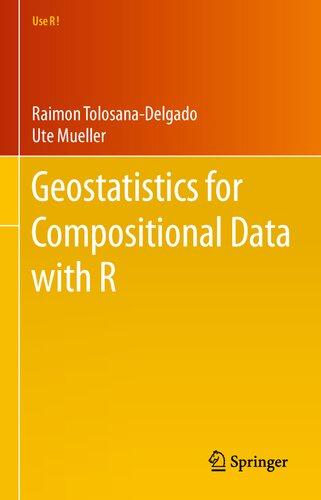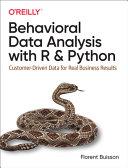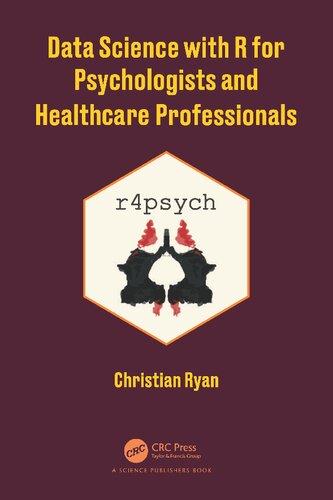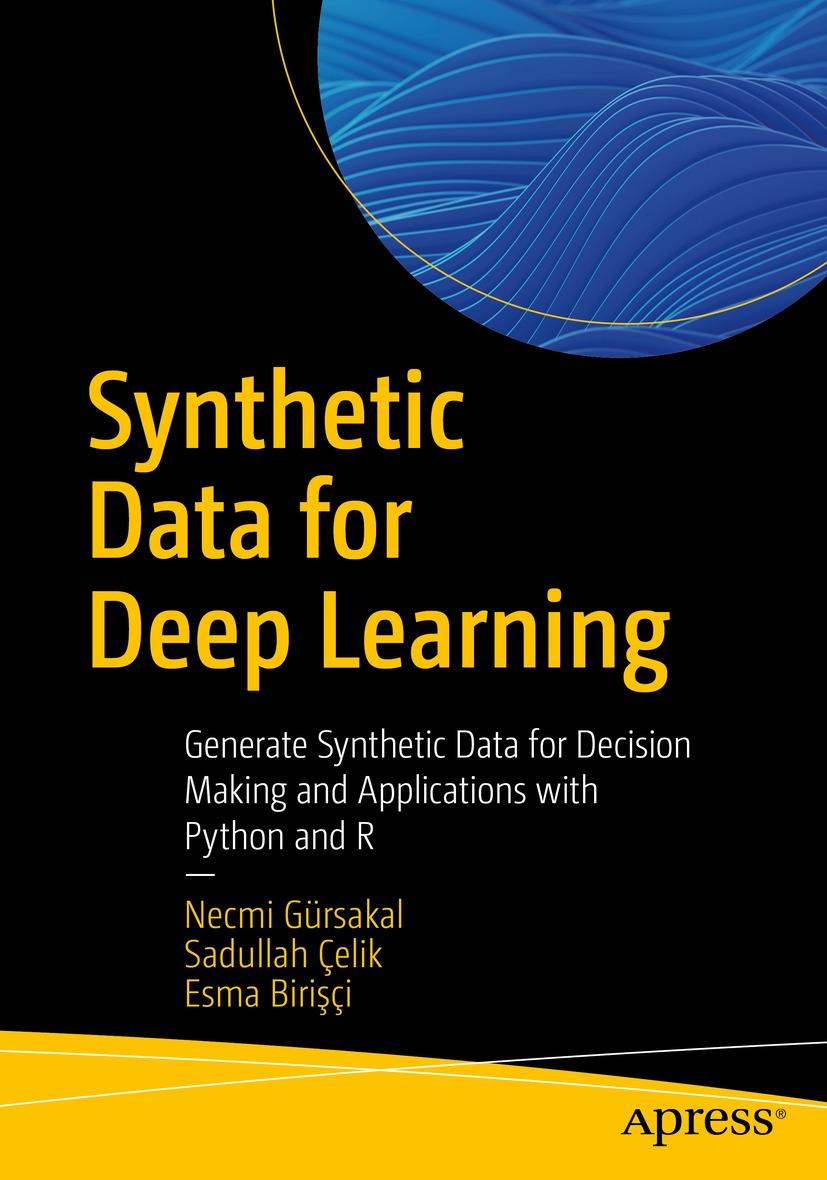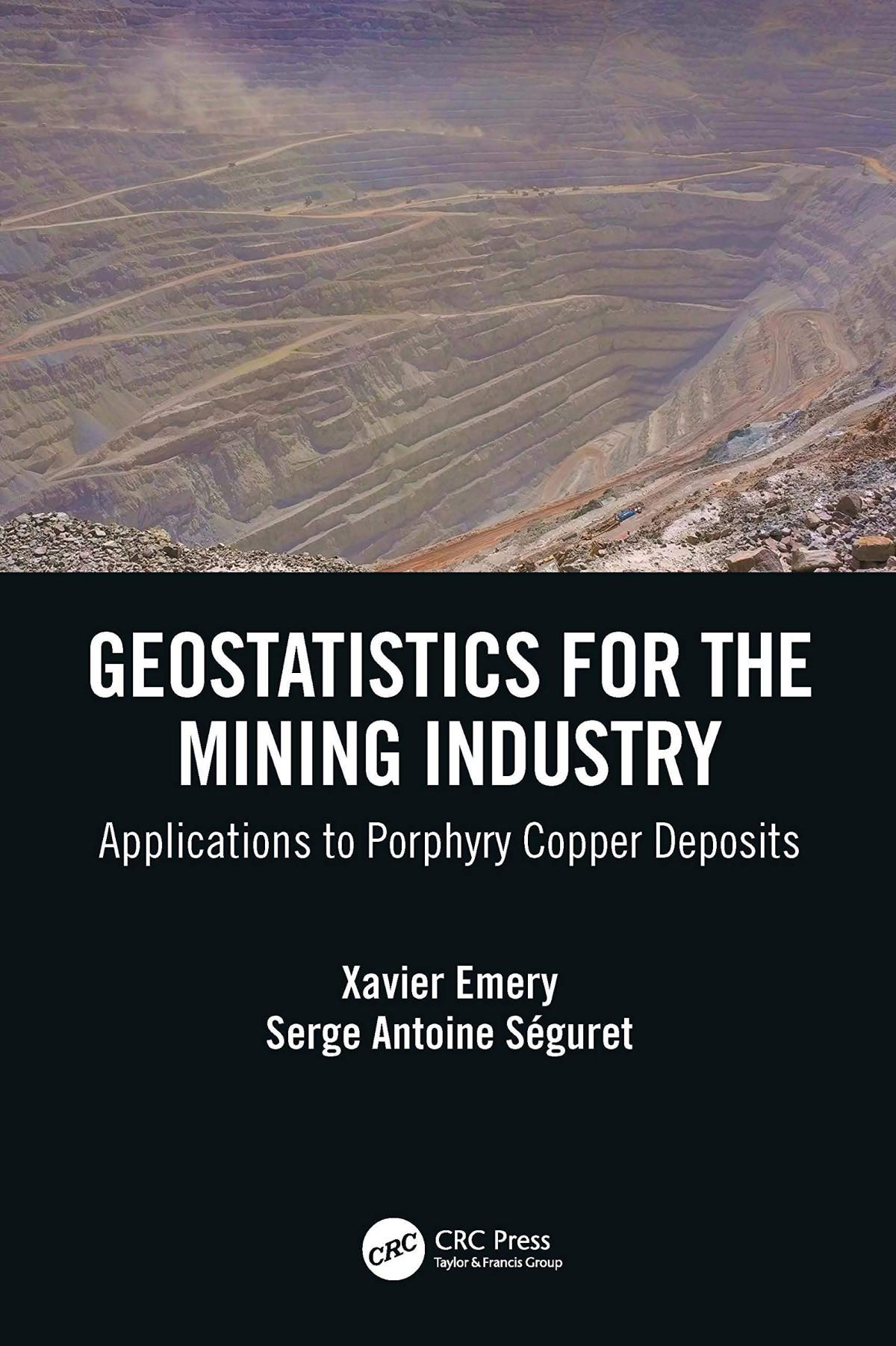Geostatistics for Compositional Data with R Raimon Tolosana-Delgado Visit to download the full and correct content document: https://ebookmeta.com/product/geostatistics-for-compositional-data-with-r-raimon-tolo sana-delgado/
More products digital (pdf, epub, mobi) instant download maybe you interests ...
Data Science for Business With R 1st Edition Jeffrey S. Saltz
https://ebookmeta.com/product/data-science-for-businesswith-r-1st-edition-jeffrey-s-saltz/
Behavioral Data Analysis with R and Python: CustomerDriven Data for Real Business Results 1st Edition Buisson
https://ebookmeta.com/product/behavioral-data-analysis-with-rand-python-customer-driven-data-for-real-business-results-1stedition-buisson/
Data Science with R for Psychologists and Healthcare Professionals 1st Edition Christian Ryan
https://ebookmeta.com/product/data-science-with-r-forpsychologists-and-healthcare-professionals-1st-edition-christianryan/
Big Data Analytics with R 1st Edition Simon Walkowiak
https://ebookmeta.com/product/big-data-analytics-with-r-1stedition-simon-walkowiak/
Synthetic Data for Deep Learning: Generate Synthetic Data for Decision Making and Applications with Python and R 1st Edition Necmi
Gürsakal
https://ebookmeta.com/product/synthetic-data-for-deep-learninggenerate-synthetic-data-for-decision-making-and-applicationswith-python-and-r-1st-edition-necmi-gursakal-2/
Synthetic Data for Deep Learning: Generate Synthetic Data for Decision Making and Applications with Python and R 1st Edition
Necmi Gürsakal
https://ebookmeta.com/product/synthetic-data-for-deep-learninggenerate-synthetic-data-for-decision-making-and-applicationswith-python-and-r-1st-edition-necmi-gursakal/
R Programming for Data Science Roger D. Peng https://ebookmeta.com/product/r-programming-for-data-scienceroger-d-peng/
Geostatistics for the Mining Industry: Applications to Porphyry Copper Deposits 1st Edition Xavier Emery
https://ebookmeta.com/product/geostatistics-for-the-miningindustry-applications-to-porphyry-copper-deposits-1st-editionxavier-emery/
R for Health Data Science 1st Edition Ewen Harrison
https://ebookmeta.com/product/r-for-health-data-science-1stedition-ewen-harrison/
Raimon Tolosana-Delgado
Ute Mueller
Geostatistics for Compositional Data with R SeriesEditors
RobertGentleman,23andMeInc.,SouthSanFrancisco,USA
KurtHornik,DepartmentofFinance,AccountingandStatistics,WU WirtschaftsuniversitätWien,Vienna,Austria
GiovanniParmigiani,Dana-FarberCancerInstitute,Boston,USA
ThisseriesofinexpensiveandfocusedbooksonRisaimedatpractitioners. BookscandiscusstheuseofRinaparticularsubjectarea(e.g.,epidemiology, econometrics,psychometrics)orasitrelatestostatisticaltopics(e.g.,missingdata, longitudinaldata).Inmostcases,bookscombineLaTeXandRsothatthecodefor figuresandtablescanbeputonawebsite.Authorsshouldassumeabackgroundas suppliedbyDalgaard’sIntroductoryStatisticswithRorotherintroductorybooksso thateachbookdoesnotrepeatbasicmaterial.
Moreinformationaboutthisseriesat http://www.springer.com/series/6991
RaimonTolosana-Delgado•UteMueller Geostatisticsfor CompositionalDatawithR RaimonTolosana-Delgado
Helmholtz-ZentrumDresden-Rossendorf HelmholtzInstituteFreibergforResource Technology Freiberg,Germany
UteMueller SchoolofScience EdithCowanUniversity Joondalup,WA,Australia
ISSN2197-5736ISSN2197-5744(electronic)
UseR!
ISBN978-3-030-82567-6ISBN978-3-030-82568-3(eBook) https://doi.org/10.1007/978-3-030-82568-3
©SpringerNatureSwitzerlandAG2021
Thisworkissubjecttocopyright.AllrightsarereservedbythePublisher,whetherthewholeorpartof thematerialisconcerned,specificallytherightsoftranslation,reprinting,reuseofillustrations,recitation, broadcasting,reproductiononmicrofilmsorinanyotherphysicalway,andtransmissionorinformation storageandretrieval,electronicadaptation,computersoftware,orbysimilarordissimilarmethodology nowknownorhereafterdeveloped.
Theuseofgeneraldescriptivenames,registerednames,trademarks,servicemarks,etc.inthispublication doesnotimply,evenintheabsenceofaspecificstatement,thatsuchnamesareexemptfromtherelevant protectivelawsandregulationsandthereforefreeforgeneraluse.
Thepublisher,theauthors,andtheeditorsaresafetoassumethattheadviceandinformationinthisbook arebelievedtobetrueandaccurateatthedateofpublication.Neitherthepublishernortheauthorsor theeditorsgiveawarranty,expressedorimplied,withrespecttothematerialcontainedhereinorforany errorsoromissionsthatmayhavebeenmade.Thepublisherremainsneutralwithregardtojurisdictional claimsinpublishedmapsandinstitutionalaffiliations.
ThisSpringerimprintispublishedbytheregisteredcompanySpringerNatureSwitzerlandAG. Theregisteredcompanyaddressis:Gewerbestrasse11,6330Cham,Switzerland
Preface Theneedforaspecializedgeostatistical treatmentofcompositionaldatabecame evidentforthefirsttimeatthebeginningofthe1980sduringthedoctoral studiesofVeraPawlowsky-Glahn,Raimon’sformerPhDsupervisor.Althoughshe alreadyproposedthefundamentalideasandmostofthetoolsforthistask,the matterslumberedforalmosttwodecadesoutofsightofpractitionersandthe generalgeostatisticscommunity.Reasonsweresometheoreticalconcernsabout theunbiasednessoftheproposedestimators,aswellasacompletelackofuserfriendlysoftware.Theadventof R inthe2000schangedthis:withtheappearance ofpackages“gstat”formultivariategeostatisticsand“compositions”for compositionaldataanalysis,itbecamepossibletomixandmergetoolsfromthem andsuccessfullytacklecompositionalgeostatisticswithjustafewlinesofcode.
Withthatidea,wegaveashortcourseoncompositionalgeostatisticsin2012at EdithCowanUniversityinPerthandthenanotherduringthe2015AnnualConferenceoftheInternationalAssociationfor MathematicalGeosciences,ourcommon scientifichomeofmanyyears.ForthecourseatIAMG2015,wewroteapreliminary versionofthesematerials,includingmethodsandcodethatwerestateoftheartat thattime.Withthatwisdom,andnewresultswithourco-authorsinChaps. 8 and 10,weendedupwritingthisbookandprogramming“gmGeostats”,anownnew packageseamlesslybridgingbetween“compositions”and“gstat”.
Thescopeofthisbookisthusthespatialanalysisofregionalisedcompositions, usingthesethreepackageswithin R.Wecoverbothcompositionaldataanalysisand geostatisticsfromscratch,sothatpeoplenewtooneorbothofthesefieldscanlearn them,includingbasictheory,necessarytoolsandpracticaltips.Someknowledgeof linearalgebra,probabilitytheory,statisticsandaminimalRprogramminghelpin followingtheexplanations,althoughthey arenotabsolutelynecessary.Thebook isthusappropriateforawidevarietyofreaders,fromfinal-yearundergraduate studentstoseniorresearchers,andfromindustrypractitionerstoacademics.Our experience,datasets,andexamplescome allfromthegeosciences,inparticular miningandenvironmentalgeochemistry.However,readersshouldnotthinkthatthe methodsandtoolsofthisbookarenotrelevanttothem:compositionalgeostatistics hasalreadyprovenrelevantinbiosciences,ecology,geophysics,geohealthstudies,
forensics,pedologyandineveryscientificfieldwheredatainproportionsor percentagesaregeolocalizedandmodellingthespatialdependencebetweenthemis relevantforthescientificquestionathand.
Thebookcanbedividedintofourmainblocks,thoughthesearenotformally representedinthebookstructure.Thefirsttwochapters(blockone)setthe frameworkandprovidesomebackgroundon compositionaldataanalysis.Chapters 3 and 4 (blocktwo)providecompositionalexploratorytoolsforbothnon-spatial andspatialaspects.Chapters 5 to 9 (blockthree)coverallnecessaryaspectsof multivariateGaussiangeostatisticsforcompositionaldata,includingvariogram modelling,cokriging,validation,transformationstomultivariatenormalityand cosimulationalgorithms.Finally,Chap. 10 (blockfour)presentsthekeyideasfor amultipointsimulationofcompositionaldata,illustratedinthecaseofthedirect samplingalgorithm.Chapter 11 andtheappendixarerelevantforboththeGaussian andthemultipointroutesandcanthereforebeviewedasendpointsforbothblocks threeandfour.Readersarerecommendedtogetfamiliarwiththematerialsfromthe firsttwoblocksbeforegoingintotheotherchaptersofthebook.
Freiberg(DE),GermanyRaimonTolosana-Delgado Perth(AU),WA,AustraliaUteMueller July2020
Acknowledgements Thisbookwouldhavenotbeenpossiblewithouttheyearsofdiscussionand collaborationwithalotofpeople,mostsignificantlyGeraldvandenBoogaart andHassanTalebi,co-authorsoftwoofthechapters,andVeraPawlowsky-Glahn, JuanjoEgozcueandJenniferMcKinley, withwhomwehavecollaboratedoveryears onmattersofgeostatisticsandcompositionaldataanalysis.HassanTalebiandWill Pattonagreedtoserveasguineapigsandthoroughlycheckedapreliminaryversion ofthismanuscript,greatlyimproving it.Theaccompanyingpackagetothisbook, “gmGeostats”,alsoprofitedfromcodebyHassanandGerald,aswellasfrom discussionsonthedidacticsandstructureofmultivariategeostatisticswithmanyof ourPh.D.studentsandparticipantsofpostgraduatecoursespastandpresent.
TheInternationalAssociationforMathematicalGeosciences(IAMG),theGermanAcademicExchangeService(DAAD)andUniversitiesAustralia,aswell asourinstitutions,theHelmholtz-ZentrumDresden-RossendorfandEdithCowan University,providedtheframeworkforourcollaboration,coveringshortandlong staysvisitingeachother;inparticular,EdithCowanUniversityfundedasemester ofstudyleaveduringwhichUtevisitedRaimoninFreiberg.
Lastbutnotleast,wethankourpartnersDirkandAndreas,whosupportedus andenduredusandourabsencesduringtheseyearsofprogrammingandwriting together.
1Introduction .................................................................1
1.1WhatIsCompositionalGeostatistics?
1.2WhyUseaCompositionalApproach?
1.3.1WindarlingIronOreData
1.3.2TellusHorizon:ASoilData ................................4
1.3.3NationalGeochemicalSurveyofAustralia
1.4Relevant
2AReviewofCompositionalDataAnalysis
2.1.1TheClosure
2.1.2The R-PackageCompositions
2.1.3ProblemsofClosedData ...................................14
2.1.4SubcompositionalCoherenceandScaleInvariance
2.1.5AlternativeFrameworksofCompositions
2.2Log-RatioTransformations
2.3CompositionalGeometryoftheSimplex
2.3.1TheSimplex
2.3.2CompositionalDistances
2.3.3AnEuclideanVectorSpaceStructure
2.3.4AffineEquivarianceandthe“Best”Transformation
2.4Zeroes,MissingsandValuesBelowDetectionLimit
3ExploratoryDataAnalysis
3.1GraphicalRepresentations
3.2FirstandSecondOrderMoments
3.4AdditiveLogisticNormality(ALN)andMahalanobisMetric
3.5OutliersandRobustness .............................................39
4ExploratorySpatialAnalysis
4.1The R-packages“sp”,“gstat”and“gmGeostats
4.2SpatialDataAnalysis
4.2.1MapsandPlots
4.3Variograms
4.3.1RawVariograms
4.3.2PracticalAspects
4.3.3VariogramsforCompositionalData:Coordinate Variography .................................................55
4.3.4VariogramsforCompositionalData: Variation-Variograms .......................................57
4.3.5RelationshipsBetweenStructuralFunctions
4.3.6Anisotropy
4.4MAF
4.4.1Method
4.4.2MAFBiplots
4.5ChecksofSpatialStructure ..........................................71
4.5.1SpatialDecorrelation .......................................71
4.5.2SpatialIndependence
4.6Example:Tellus ......................................................74
5.1LinearModelofRegionalisation ....................................83
5.2LinearModelofCoregionalisation ..................................85
5.2.1MultivariateRandomFunction ............................85
5.2.2Log-RatioInvarianceoftheLMC .........................86
5.2.3PracticalModellingProcedure .............................87
5.3ModelFunctionsandModelFitting .................................89
5.3.1Packages“gmGeostats”,“compositions” and“gstat” ...............................................89
5.4FactorialRepresentations ............................................92
5.4.1PCA .........................................................92
5.4.2MAF .........................................................93
5.4.3Rank-OneStructures .......................................94
5.5Example:VariogramModelsfortheWindarlingData
6GeostatisticalEstimation ..................................................105
6.1Cokriging
6.2CokrigingoftheMean
6.3Comments ............................................................108
6.3.1ImplementationPracticalities
6.3.2Properties ...................................................108
6.3.3Unbiased,inWhichScale?
6.3.4Cokrigingin R
6.4CokrigingEstimationofWindarlingData
6.4.1OrdinaryCokriging
6.4.2UniversalCokriging
6.4.3EstimationoftheLocalandGlobalMean
6.4.4ComparisonofOCKandUCKResults
6.5EstimationofTellusDataSubcomposition
7Cross-Validation
7.1Introduction
7.2Cross-ValidationintheUnivariateCase
7.3MultivariateCross-Validation
8MultivariateNormalScoreTransformation
K.GeraldvandenBoogaart,UteMueller, andRaimonTolosana-Delgado
8.1Introduction
8.2FlowAnamorphosis
8.3Properties
8.4ApplicationtoWindarlingData
9.2.1SequentialGaussianSimulation
9.2.2LUDecompositionSimulation
9.2.3TurningBands
9.2.4Comments ...................................................170
9.3SimulationofaRandomFunctionviaUnivariate SimulationofPCAorMAFFactors
9.4AccuracyandPrecisionPriortoSimulation
9.5Example:WindarlingData ...........................................172
9.5.1CosimulationwithanLMC ................................172
9.5.2SimulationThroughMAFDecomposition
10CompositionalDirectSamplingSimulation .............................187
HassanTalebi,UteMueller,andRaimonTolosana-Delgado
10.1Introduction ...........................................................187
10.2CompositionalDirectSamplingSimulation
10.3.1Implementation
10.3.3TrainingImageGeneration
10.4Example:DirectSamplingSimulation ofaSubcompositionoftheTellusData .............................190
10.4.1TrainingImageandRegridding
10.4.2ConditionalSpatialModel
10.4.3Simulation ..................................................195
10.5Example:DirectSamplingSimulationofWindarling EastDataBasedonWindarlingWest ...............................199
11.1.1ValidationoftheSimulationModel .......................209
11.1.2IndividualRealisationMaps ...............................212
11.1.3StatisticalMaps .............................................212
11.1.4ReproductionofTargetMarginalandTwo-Point
11.1.5SelectivityCurves ..........................................219
11.2Postprocessing ........................................................221
11.2.1Block-COKThroughLocalSimulation
B.2ModellingtheSpatialContinuity
B.3Estimation
B.4Simulation
B.5EvaluationandPostprocessing
ListofSymbols A Accuracyofaspatialmodel
alrAdditivelog-ratiotransform
C [z]
Closureofthecompositionalvector z clrCentredlog-ratiotransform
dA (z, z )
dAM (z, z |S)
Aitchisondistancebetween z and z
Aitchison-Mahalanobisdistance
dDSA (E (x), E TI (xTI )) Distancebetweendataeventanddataeventintraining image
dH (z, z )
dmm (z, z )
E (x)
E TI (xTI )
fZ (·|g, S)
DiscreteHellingerdistancebetween z and z
Manhattandistancebetween z and z
Dataeventat x
DataeventintrainingimageTIat xTI
Probabilitydensityofarandomcompositionwithadditivelognormaldistribution,centre g andspreadform S glrGenericlog-ratiotransform
γ (h)
g(·|θ)
G
G(c)
Γ (h)
ˆ
Γ (h)
ˆ
g
i( )
Icond (x)
Univariatevariogramatlag h
Unitaryvariogrammodelfunctionwithparameters θ
Goodnessofaspatialmodel
Gradeabovecutoff c
Variogrammatrixatlag h
Experimentalvariogrammatrixatlag h
Geometriccentre
Binary-valuedfunction,i.e.afunctionofseveralargumentsreturningeither0or1
Indicatorrandomfunction,withvalue1ifthecondition indicatedistrueatlocation x and0otherwise
ilrIsometriclog-ratiotransform
κ(h)
Spatialdiagonalizationefficiencyatlag h
MAFMinimummaximumautocorrelationfactorization
ME
MSE
Cross-validationmeanerror
Cross-validationmeansquareerror
MSDR1
MSDR2
Affineequivariantmeansquaredeviationratio
Meansquaredeviationratio
P Precisionofaspatialmodel
PCAPrincipalcomponentanalysis
Ψ Transformationfromcompositiontocoordinaterepresentation
Φ Transformationfromcoordinaterepresentationtocomposition pwlrPairwiselog-ratiotransform
ρ(·|θ)
σ 2
OCK (x0 )
σ 2
SCK (x0 )
σ 2
UCK (x0 )
Σ
OCK (x0 )
Σ
SCK (x0 )
Σ
UCK (x0 )
SD
Correlogramwithparameters θ
Ordinarycokrigingestimationvarianceatlocation x0
Simplecokrigingestimationvarianceatlocation x0
Universalcokrigingestimationvarianceatlocation x0
Ordinarycokrigingerrorcovariancematrixatlocation x0
Simplecokrigingerrorcovariancematrixatlocation x0
Universalcokrigingerrorcovariancematrixatlocation x0
D -partsimplex
ˆ S Variance-covariancematrixofthelog-transformeddata setln(Z)
ˆ T Variationmatrix
T(h)
Variation-variogram
ˆ T(h) Experimentalvariation-variogram
T(c) Tonnageabovecutoff c
TITrainingimageusedindirectsampling
τ(h)
totvar(x)
Relativedeviationfromdiagonalityatlag h
Globaldispersionofsimulatedcompositionat x x Spatiallocation
y Normalscorevector
Y Normalrandomvector
z Compositionalvector
Z Randomcomposition
ζ(h)
ζ ∗
SCK (x0 )
∗
ζ
OCK (x0 )
∗
ζ
UCK (x0 )
z
∗ (x)
Absolutedeviationfromdiagonalityatlag h
Simplecokrigingestimateatlocation x0
Ordinarycokrigingestimateatlocation x0
Universalcokrigingestimateatlocation x0
E-typemeanofsimulatedcompositionat x
⊕ Perturbation
Inverseperturbation
Powering
, A
Scalarproduct
ListofFigures Fig.2.1Ternarydiagramasrepresentationofthesamplespace S3 ........19
Fig.3.1Exampleofarepresentationinaternarydiagram,with indicationofhowtoreadtheproportions:10%A,30% Band60%C .........................................................28
Fig.3.2Exampleoftheprincipleofparallelplotting,and trackingofindividualobservations,viaamatrixof HarkerdiagramswiththeWindarlingdataset .....................29
Fig.3.3Matrixofbivariatekerneldensityplotsoffour componentsoftheclr-transformedWindarlingdataset ...........30
Fig.3.4Matrixofpairwiserepresentationofacomposition, whereeachpanelrepresentstheestimateddensity distributionofthecomponentintherowdividedbythe componentinthecolumn ...........................................31
Fig.3.5Pairwiselog-ratioboxplotsofafour-component subcomposition;verticalscalesinlogscaling .....................32
Fig.3.6Screeplotofaclr-PCAoftheWindarlingdata,and cumulativeproportionofexplainedvariancewith100% and95%referencelines .............................................36
Fig.3.7ColouredbiplotofthefirsttwoPCsofaclr-PCAof Windarlingdata ......................................................37
Fig.3.8TernarydiagramsoftheWindarlingdataset,with indicationoffirstprincipalcomponentofthe subcomposition.ColourlegendafterFig.3.7 ......................38
Fig.3.9Pairwiselog-ratiopairsQQ-plotsforthefitofanormal distributiontothesubcomposition(Fe,SiO2 ,Al2 O3 ,R) oftheWindarlingdataset.Thinlineisthenormalreference .....40
Fig.4.1SpatialmapsoftheWindarlingcompositionwith proportionalsymbols ................................................48
Fig.4.2SpatialmapsoftheWindarlingcompositionin alr-coordinatesrelativetothevariableR ...........................49
Fig.4.3Swathplotsofpairwiselog-ratiosofWindarlingdatain theEWdirection .....................................................50
Fig.4.4Swathplotsofpairwiselog-ratiosofWindarlingdatain theNSdirection .....................................................51
Fig.4.5Mapsofsamplelocations,withcoloursaccordingto lithotype(upperpanel)anddegreeofanomalityinthe subcomposition(Fe,SiO2 ,Al2 O3 ,Mn)(lowerpanel) ............52
Fig.4.6Commonelementsforthequalitativedescription ofavariogram .......................................................54
Fig.4.7Experimentalvariation-variogramsofWindarlingdata ...........58
Fig.4.8Experimentalvariation-variogramsofWindarlingdata computedforatotalseparationdistanceof50mata nominalspacingof2.5m ............................................59
Fig.4.9Alrrepresentationoftheexperimentaldirectandcross variogramsoftheWindarlingdataset ..............................62
Fig.4.10Variation-variogrammapsofWindarlingdatacomputed foratotalseparationdistanceof50matanominal spacingof5m ........................................................63
Fig.4.11Experimentalvariation-variogramsofWindarlingdata computedforatotalseparationdistanceof50mata nominalspacingof2.5m,directionN0(NS)isshownin turquoiseanddirectionN90(EW)inred ...........................64
Fig.4.12Variation-variogrammapsoftheeasternpartof Windarlingdatacomputedforatotalseparationdistance of45matanominalspacingof5m ................................65
Fig.4.13Variation-variogrammapsofwesternpartofWindarling datacomputedforatotalseparationdistanceof45mat anominalspacingof5m ............................................66
Fig.4.14Experimentaldirectandcrossvariogramsofthe WindarlingMAFfactorsbasedontheilr-covariance matrixandthematrixatlag1 .......................................68
Fig.4.15ExperimentalvariogramsoftheWindarlingMAFfactors basedontheilr-covariancematrixandthematrixatlag 1indirectionsN90(green)andN0(blue) .........................69
Fig.4.16MAFbiplotsoffirstvs.secondfactorandofthirdvs. fourthfactor,basedonthecovariancematrixandthe matrixatlag1 .......................................................70
Fig.4.17Spatialdiagonalisationmeasuresfortheoriginal alr-transformedWindarlingdataset,andforitsMAF representation ........................................................73
Fig.4.18Experimentalvariation-variogramsobtainedforthe referencesubsetofTellus ...........................................75
Fig.4.19ilrvariogramsobtainedforthereferencesubsetofTellus .........76
Fig.4.20BiplotsandselectedternarydiagramsoftheTellusdata set.Thebiplotisobtainedforthereferencesubset.The ternarydiagramsshowboththereferencesubset(red circles)andthecompleteset(blackdots) ..........................77
Fig.4.21MAFbiplotoftheTellusdataset,forthewholedata (left)andforthereferencesubset(right) ...........................78
Fig.4.22MAFvariogramsoftheTellusdataset,referencesubset, composition(MgO,Al2 O3 ,CaO,Fe2 O3 ,R) .......................79
Fig.4.23Graphsofthespatialdecorrelationmeasuresfor alr-transformed(left),ilr-transformed(centre)andMAF transformed(right)Tellussubcomposition .........................79
Fig.5.1Mostcommonlyusedunitaryvariogrammodels, behaviourneartheoriginisshownintheleftplot .................85
Fig.5.2AutofittedisotropicLMCforWindarlingcomposition comprisedofanuggetandanexponentialstructure ...............95
Fig.5.3IsotropicLMCforWindarlingcompositioncomprised ofanuggetandtwosphericalstructures ...........................97
Fig.5.4Experimentaldirectionaldirectandcrossvariogramsin directionsN90(red)andN180(black)forWindarling composition ..........................................................99
Fig.5.5AnisotropicLMCforWindarlingcomposition comprisedofanuggetandanexponentialstructure ...............100
Fig.5.6LMCforWindarlingcompositionderivedfromthe MAFdecomposition,inpwlrformat ...............................102
Fig.5.7LMCforWindarlingcompositioninalr-coordinates derivedfromtheMAFdecomposition .............................103
Fig.5.8LMCforWindarlingcompositioninilr-coordinates derivedfromtheMAFdecomposition .............................104
Fig.6.1Cokrigingestimate(top)andestimationvariance (bottom)oflog( Fe R ) ................................................112
Fig.6.2OCKestimationregion,estimationvariancesoflog( Fe R ) above0.9masked ....................................................113
Fig.6.3OCKestimatesforWindarlingdatawithmodel wind.alr.ggAnis ..............................................114
Fig.6.4SpatialmapofUCKestimatesof ζ1 = log( Fe R ) ...................116
Fig.6.5UCKestimatesforWindarlingdatawithmodel wind.alr.gg.uck ..............................................117
Fig.6.6SpatialmapofUCKestimatesofFewithsampledata superimposed ........................................................117
Fig.6.7Local(top)andglobal(bottom)trendestimatesfor Fe(left)andP(right)atWindarlingwithanisotropic ordinarycokrigingandwithisotropicuniversalkriging withNStrend.Notethateachvariablehasitsowncolour scale .................................................................119
Fig.6.8KerneldensityestimatesofOCK(red)andUCK(blue) estimatesandrawdata(black) ......................................122
Fig.6.9Boxplotscomparingconditioningdata,OCKandUCK estimates .............................................................122
Fig.6.10QQ-plotsofOCKestimatesagainstconditioningdata (left),UCKestimatesagainstconditioningdata(centre) andOCKestimatesagainstUCKestimates(right) ................123
Fig.6.11BiplotsforOCK(left)andUCK(right) ............................124
Fig.6.12DistributionsofpredictionswithOCKandUCKon ternarydiagram.ComparewiththoseofFig.3.8 ..................124
Fig.6.13Variation-variogrammapsfortheTellussubcomposition inthesamplesetsubset .............................................126
Fig.6.14Variogrammodelstogetherwithexperimental variogramsformaf1tomaf4 .......................................127
Fig.6.15OKestimateoffirstMAFoftheTellussubcompositon withmaf1sampledatasuperimposed ..............................128
Fig.6.16KrigingestimatesofFe2 O3 ,Al2 O3 ,CaOandMgO basedonOKoftheMAFfactors ..................................129
Fig.6.17Histogramsofestimates,truedataandQQ-plotsof estimatesagainsttruedata ..........................................130
Fig.7.1Leaveoneoutcross-validationresultsoflog( Fe R ) based ontheLMC wind.alr.ggAnis ...............................137
Fig.7.2Variogramoftheresidualsoftheleaveoneout cross-validationoflog( Fe R ) basedontheLMC wind.alr.ggAnis:(red)azimuth=90,(blue) azimuth=180 .........................................................138
Fig.7.3Cross-validationresultsfortheLMCofthe alr-transformedWindarlingdata:Observationsagainst predictions,histogramsofresiduals,normalQQ-plots forresiduals,scatterplotsresidualsagainstpredictions andboxplotsofpredictionerrorsbylithology(Toptobottom) ...140
Fig.7.4Cross-validationresultsfortheLMCofthe alr-transformedWindarlingdata:log-ratioresidualsand log-ratioobservationsagainstlog-ratiopredictions ................141
Fig.7.5Directandcross-variogramsontwodirections(90=EW; 180=NS)oftheresidualsofacokrigingbasedleaveone outcross-validationofWindarling,model wind.alr. ggAnis .............................................................143
Fig.7.6Spatialmapsofcross-validationresidualsofthe Windarlingdata ......................................................144
Fig.7.7JackknifevalidationresultsforWindarlingsubset windarlingJ,derivedfromthemodelbasedonthe entiresetandthesampleset windarlingS,1strow: truevaluesagainstestimates;2ndrow:histogramsof residuals;3rdrow:QQ-plotsofresiduals;4throw: standardisederrorsagainstestimates;and5throw: boxplotsofresidualsbylithotype ..................................146
Fig.7.8Multivariatecross-validationresultfortheLMCofthe alr-transformedWindarlingdata:QQ-plotof MSDR1 againstthe χ 2 distributionwith5degreesoffreedom .............147
Fig.7.9Accuracyplotofthecross-validationoflog( Fe R ) based ontheLMC wind.alr.ggAnis ................................150
Fig.7.10Accuracyplotofthecross-validationofthecokriging modelfortheWindarlingcomposition .............................151
Fig.8.1BivariatedensityplotsofnormalscoresforWindarling dataderivedfromquantilematching ...............................159
Fig.8.2BivariatedensityplotsofnormalscoresforWindarling dataderivedfromFA ................................................160
Fig.8.3NormalitycheckfornormalscoresofWindarlingdata derivedfromFA .....................................................160
Fig.8.4SpatialmapsofnormalscoresforWindarlingdata derivedfromFA .....................................................163
Fig.8.5Directandcrossvariogramsofnormalscoresfor WindarlingdataderivedfromFA ...................................164
Fig.8.6SpatialdecorrelationmeasuresforFAnormalscoresof Windarlingdata ......................................................164
Fig.9.1LMCforFAnormalscoresofWindarlingdata ....................173
Fig.9.2OnesimulationofFe,comparedwiththeoriginalvalues ofFeinWindarling ..................................................176
Fig.9.3Experimentalomnidirectionaldirectandcrossvariogram ofMAFtransformedFAnormalscoresofWindarling data ..................................................................177
Fig.9.4TestofspatialdecorrelationofMAFtransformedFA scores:Relative(left)andabsolutedeviationfrom diagonality(right) ...................................................177
Fig.9.5HistogramsandQQ-plotsofMAFscoresderivedfrom FAnormalscoresofWindarling ....................................178
Fig.9.6SpatialmapsofMafFactorsofFA-transformednormalscores ...179
Fig.9.7DensityplotsoftheMAFfactorsofthenormalscoresof Windarling ...........................................................180
Fig.9.8VariogrammodelsfortheWindarlingMAFtransformed FAnormalscores ...................................................181
Fig.9.9Cross-validationresultsformodelsofMAFtransforms ofnormalscoresforWindarlingdata ...............................183
Fig.9.10OnesimulationofFeviaMAFdecomposition, comparedwiththeoriginalvaluesofFeinWindarling ...........184
Fig.10.1CompositionaltrainingimagegeneratedfromTellussoil geochemicaldata ...................................................194
Fig.10.2ConditioningcompositionaldatafromTellusXRFdata set ....................................................................196
Fig.10.3Arandomlyselectedrealisationoftheconditional simulationviacompositionaldirectsamplingalgorithm .........198
Fig.10.4Windarlingdatasamplelocations,thewesternpart (Easting<0m)willbedeemedexhaustiveandtakenas thetrainingimage ...................................................200
Fig.10.5Windarlingtrainingandconditioningdatalocationsand underlyingregulargrid ..............................................201
Fig.10.6Migrateddata(top)andoriginaldata(bottom)forFe,P, Al2 O3 andSiO2 .....................................................202
Fig.10.7QQ-plotscomparingtrueandmigrateddata .......................203
Fig.10.8WindarlingEastsimulationregion .................................204
Fig.10.9OnerandomlychosenDSrealisationofcompositionsin theEasternpartoftheWindarlingbench ..........................206
Fig.11.1E-typeestimatesoftheexpectedvalueofthe compositioninrawscalefortheWindarlingdataset, basedonsequentialGaussiansimulations .........................213
Fig.11.2Totalvariationestimateofthecompositionforthe Windarlingdataset,basedonsequentialGaussian simulations ...........................................................214
Fig.11.3Boxplotsofthesimulatedcompositionalmeansof thewholeWindarlingdeposit,comparedwiththe compositionalmeansofthedata(circles) ..........................215
Fig.11.4SwarmQQ-plotsoftherealisationsofthecomposition atWindarling,comparedwiththeobserveddistribution ofeachvariable ......................................................217
Fig.11.5Boxplotsofthedistributionmeansquaredeviationsfor eachsimulationandeachvariable ..................................218
Fig.11.6VariogramswarmsforWindarlingFeandPsimulated realisations,comparedwiththevariogramsofthe originaldata(reddots) ..............................................219
Fig.11.7Grade-tonnagecurves ofeachvariableatWindarling, basedonthecosimulationstrategy .................................222
Fig.11.8MapofblockE-typespatialmeanaggregatesofFe ...............224
Fig.11.9E-typeestimatesandtotalvarianceofthe subcompositionfortheTellusdataset,outof25direct samplingsimulations ...............................................227
Fig.11.10SwarmsofQQ-plotsoftherealisations(greylines)of thefiveelementsoftheTellussubcompositionandof thetrainingimage(bluelines),againstthedistribution ontheconditioningdata(redreferenceline) .......................228
Fig.11.11Directsamplingaccuracy plotsforeachoriginalvariable andforthewholecompositionoftheTellussubcomposition .....229
ListofTables Table5.1Mostcommonlyusedvariogrammodels,expressed asfunctionsofananisotropicdimensionlessdistance r 2 = ht E 1 h,where E describesanellipse(orellipsoid in3Dspace)withnon-negligiblespatialcorrelation, δ(r) = 1for r = 0and δ(r) = 0for r> 0,and χ1 denotesthecharacteristicfunctionfortheset {r : 0 ≤ r ≤ 1} .......................................................84
Table5.2Namesofthemostimportantvariogrammodelsfoundin thepackages“gstat”and“compositions”.Package gmGeostats understandsbothspecifications .....................90
Table5.3Sillmatricesofnugget(first5rows)andexponential structure(last5rows)oftheisotropicLMCfor Windarling,alsoshowninFig.5.2 ..................................96
Table5.4Sillmatricesofnugget(first5rows),short-range(rows6 to10)andlong-range(lastfiverows)sphericalvariogram structuresforWindarling,alsorepresentedinFig.5.3. .............97
Chapter1 Introduction Abstract Thischapterprovidestheframeworkforthecontentsofthisbook.This includesabriefintroductiontotheproblem ofgeospatialanalysisofcompositional dataandapproachestothesolution.Additionally,thedatasetsandthe R packages usedthroughoutthebookarepresented.
1.1WhatIsCompositionalGeostatistics? Geostatisticalmodellingplaysakeyroleintheevaluationofspatiallydistributed datafromavarietyofEarthandenvironmentalengineeringandsciencebackgrounds,mostparticularlyinnaturalresources(mining,oil,fisheries,water,etc). Examplesfromageologicalperspectiveincludedatacollectedfromageochemical survey,whereitisnotuncommonthatforeachsampleconcentrationsofmore than30elementsareanalysed,butalsosizedistributiondataand,morerecently, mineralproportionsdata.Therearealsomanyapplicationsintheenvironmental domain,wheretheissueismorecommonlythecharacterisationofcontaminants. Theanalysisandmodellingofsuchdataoftenrequiretaking intoaccountnotonly spatialaspects,butalsothefactthatthesedataaremultivariate,havenon-negative valuesthatareoftenconstrainedtosum toaprespecifiedtotal,andinformofthe relativeimportanceorabundanceofsomepartsformingawhole.Thus,theyare compositionaldata.Indescribingsuchdataonethereforespeaksofaregionalised composition.
Inparticulartheconstantsumconstrainthasundesirableconsequences,such asinducingspuriouscorrelations,aneffectthatwasrecognisedquiteearlyon (Pearson, 1897;Chayes, 1960).Severaldisciplesspeakofspuriouscorrelation:in thecontextofcompositionaldata,thetermreferstothefactthatcorrelationbetween twopartschangesunpredictablydependingonwhatotherpartsareconsideredin thecomposition.Inaddition,thenon-negativityofcompositionaldataneedstobe accountedforinstatisticalmodellingandso standardtechniquesarenotdirectly applicable.Thisledtotheintroductionof compositionaldataanalysis,whichtakes theseissuesintoaccount.Oneofthekeyaspectsisthemappingofthe D -simplexto (D 1)-dimensionalrealspaceviaoneoftheseverallog-ratiotransforms.Thisisthe
©SpringerNatureSwitzerlandAG2021
R.Tolosana-Delgado,U.Mueller, GeostatisticsforCompositionalDatawithR, UseR!, https://doi.org/10.1007/978-3-030-82568-3_1
topicofChap. 2,particularlySect. 2.2.Oncethetransformationhasbeeneffected, standardstatisticalandgeostatisticalmethodscanbeapplied,aslongasthese techniquesaremultivariate.Thisbookfollowsthisstraightforwardapproachand showshowtoembedthesetransformationsandtherelativenatureofregionalised compositionsintheirspatialanalysis.
1.2WhyUseaCompositionalApproach? Amultivariateobservationiscompositionalifitisformedbyseveralvariables thatjointlydescribetherelativeweight,importanceorinfluenceofapartwith respecttoawhole.Asmentionedbefore, compositionaldataareaffectedbythe spuriouscorrelationproblem.Asaconsequencethecommoninterpretationof correlationisnolongervalid,thatis,correlationdoesnotrepresentavalidmeasure oflinearassociationbetweentwocomponents.Thiscarriesovertogeo-referenced compositions,astheirspatialauto-andcross-correlationfunctionsareasspurious ascorrelationcoefficientsarefornon-regionalisedcompositions(Pawlowsky, 1984, 1989;Pawlowsky-Glahnetal., 1995).
Itisarguablethatthisspuriousnesshasnopracticalrelevance,giventhatthe unbiasednessconditionsofcokriging(Chap. 6)stronglylimittheinfluenceof anyvariableonthe other variables.Togetherwithahistoricalstrongfocusof theminingindustryononesinglevariable(onevaluemetal,onecontaminant, etc.),thisexplainstheunderstandingthatonecanapplyunivariategeostatistics consideringeachvariableseparately.Butthetwenty-firstcenturyhasbrought severaltrendsthatchallengethisapproach.Itisnowunderstoodthatthevalueof amineisstronglycontrolledbythemineralcompositionandmicrostructureof boththeoresandthewaste;thatproductivityofanoil,gasorwaterreservoiris afunctionofthediageneticprocessesformingitshostrock,andtheseinturnof itspetrographiccompositionandtexture;thatenvironmentalremediationneedsand strategiesdependonthebioavailabilityofpollutants,thatis,ontheforminwhich theseareboundtothesoil.Alltheserequire thecompositionalcharacterisationof theassetoritsmediumandamodellingstrategycapturingtherelationshipsbetween thevariouscomponentsofthesystem.Atthesametime,analyticaldevelopments aremakingthiswealthofcompositionalinformationmeasurableincheaperand moreaccessibleways.Now,analysingeachcomponentseparatelyisnolongera reasonablestrategy,aswithitthereistheriskoflosingorblurringthosevery importantlinksandbalancesbetweenthevariables:regularitiesstemmingfromour geochemical,geological,ecologicalorpetrophysicalunderstandingofthesystem. Justasanexample,theinterpolatedcomponentsofacompositionarenotnecessarily positive,andasawholetheywillnotsumto100%,iftheyaresimplyinterpolated separately.Positivitycanbeenforcedbyanalysinglog-transformedvariables,but thentheconstantsumconstraintgetsevenlesscontrolled.Totalsuminconsistencies canbecircumventedbyinterpolatingonevariableless(reconstructingthislast variableas100%minusthesumoftheinterpolatedquantities),butthentheoutput
completelydependsontheexcludedvariable,andthenegativecomponentproblem getsoutofcontrol.Geostatisticalsimulationmakesthingsjustworse.
Intheend,thereasonfortheseinconsistenciesrunsdeeper:bytreatingeach variableseparatelyacoherent,multivariateobject—acomposition—isreplacedby alistofindividualnumbers—itscomponents—ignoringtheirinterdependencyin doingso.Ifonecomponentexplainsthe relative importanceofonepartofthewhole, howarewegoingtounderstanditifweremovethe other componentsfromthe system?Ifthereisanintrinsicrelationshipbetweensomeofthecomponents,how arewegoingtocaptureit,ifourmodellingeffortsignoreit?Thegoalofthisbookis topresentstrategiesforthegeostatisticalanalysisofregionalisedcompositionsthat allowtacklingtheseproblems,deliveringcompositionallycoherentgeostatistical models(Chaps. 5 and 8),cokriging(andkriging!)methods(Chap. 6)andsimulation strategies(Chaps. 9–11).
1.3Data Throughoutthisbookthefollowingdatasets willbeusedtoillustrateconceptsand techniquesaswellasforexercises.Oneofthedatasetsisderivedfromamining context,andtheothertwoarefromgeochemicalsurveys.Alldataareavailableas illustrationdatainpackage“gmGeostats”.
1.3.1WindarlingIronOreData Thisdatasetconsistsofasinglebenchof6mlongblasthole(BH)samples fromanironoreminelocatedinthecentralYilgarn,WesternAustralia(Ward& Mueller, 2012, 2013;Ward, 2015).Thebenchconsistsoffivediscreterotatedfault imbricates.Thelongeststrikedistance withineachhorst(constrainedbytheangular tolerance)is60meters.
AteachsamplelocationsevenanalytesandLOImeasuredinweightpercentare availablealongwiththelithotypeidentifiedduringlogging,althoughonlythefive mainelementsofinterestforironoremining(Fe,SiO2 ,Al2 O3 ,MnandP)willbe examined.Additionally,lithotypeinformationisavailable,includingschist,chert, hematiteandgoethiteores.Mostoftheworkherewillfocusondatafromthelatter twocategories.
Thedatasetisaccessiblevia >data("Windarling",package="gmGeostats") Itsworkingcopywillbenamedas windarling
1.3.2TellusHorizon:ASoilData TheTellusProject(Young&Donald, 2013)wasanextensivegeologicalmapping projectundertakeninNorthernIrelandthatconcludedin2007.Duringthesurvey nearly30,000soil,stream-sedimentand stream-watersampleswerecollected foranalysis.Themulti-elementtotalconcentrationdatapresentedcompriseXRF analysesof6862ruralsoilsamplescollectedat20cmdepthsonanon-alignedgrid atonesiteper2km2 .Thereareconcentrationdataforelevenoxides,Na2 O,MgO, Al2 O3 ,SiO2 ,P2 O5 ,SO3 ,K2 O,CaO,TiO2 ,MnOandFe2 O3 andtheelemental concentrationsforAg,As,Ba,Bi,Br,Cd,Ce,Cl,Co,Cr,Cs,Cu,Ga,Ge,Hf,I,In, La,Mo,Nb,Nd,Ni,Pb,Rb,Sb,Sc,Se,Sm,Sn,Sr,Ta,Th,Tl,U,V,W,Y,Yb,Zn, Zr.Inadditionthesampleidandthespatialcoordinatesarerecorded.Censoreddata wereimputedusingpublisheddetectionlimits.
ThedatasetneedstobedownloadedfromtheGSNIwebsite1 andpreprocessed. Within“gmGeostats”thismaybedonebythefollowingcommand: >getTellus(cleanup=TRUE,TI=TRUE) whichprepocessesthedatabyaddingaselectionvariablecalledFlagtospecifya subsetthatwillbeusedlateron.Thedatasetsoobtainediscalled TellusASoil Throughoutthecomputationsinthetextthedatasetwillbereferredtoas tellus.If the TI=TRUE issetatrainingimageisgenerated,whichwillbeusedinChap. 10
1.3.3NationalGeochemicalSurveyofAustralia TheNationalGeochemicalSurveyofAustralia(NGSA)projectwaspartofthe5yearOnshoreEnergySecurityProgrammanagedatGeoscienceAustraliabetween 2006and2011(Johnson, 2006).TheNGSAwasinitiatedtodeterminethecompositionofsurfaceregolithatthecontinentalscale.Samplingtookplacebetween 2007and2009.Theselectedsamplingmediumwascatchmentoutletsedimentfrom floodplainsorsimilarlandformslocatednearthespillpointsorlowestpointsoflarge catchments,whichwerederivedfromterrainandhydrologicalanalysis(Lechand Caritat, 2007).Ateachsite,asurface(0to10cmdepth)topoutletsedimentorTOS sampleandadeeper(onaverage60to80cmdepth)bottomoutletsedimentorBOS samplewerecollected.Forbothdepthstwo grainsizefractionsareavailableinthe dataset:coarseat < 2mmandfineat < 75µm.AnareaineasternWesternAustralia andnorthwesternSouthAustraliacouldnotbesampledduetoaccessrestrictions. Intotal,1315TOSand1315BOSsamples(including10%fieldduplicates)were collectedfrom1186catchments.
Theoverallanalysesfor60elementswereobtained.Forthesubsetconsidered here(Grunskyetal., 2017)themajorelementanalyseswereobtainedviaXRF
1 Visit http://www.bgs.ac.uk/gsni/Tellus/ todownloadtheoriginaldata.
(Al2 O3 ,CaO,Fe2 O3 (total),K2 O,MgO,MnO,Na2 O,P2 O5 ,SiO2 ,TiO2 ,Cl,S)and theremainingelementsfromthetotaldigestion(fusionfollowedbyHF+HNO3 digestion)followedbyinductivelycoupledplasma-massspectrometry(ICP-MS) analysis(Ag,As,Ba,Be,Bi,Cd,Ce,Co,Cr,Cs,Cu,Dy,Er,Eu,Ga,Gd,Ge,Hf, Ho,La,Lu,Mo,Nb,Nd,Ni,Pb,Pr,Rb,Sb,Sc,Sm,Sn,Sr,Ta,Tb,Th,U,V,W,Y, Yb,ZnandZr).Censoreddataarereportedasthenegativeofthedetectionlimit.
Allconcentrationsarereportedasthetotalelementsinpartspermillion(ppm; where1ppm=1mg/kg).Alltheaboveanalyseswerecarriedoutonfour subsamplesateachsite(TOSc/g,TOSf/g,BOSc/gandBOSf/g,intheset abbreviatedtoTc,Tf,BcandBf,respectively).Thespatialresolutionis1sample per5000km2 .
Thesurfacegeochemistrysampleswereclassifiedaccordingtothemajorcrustal blocks(MCB)ofAustraliaobtainedfromsimplifyingthemajorcrustalboundaries ofKorschandDoublier(2015a,b),andthecoordinateswereconvertedintoEastand NorthusingtheLambertConformalConicprojectionofAustralia(withstandard parallelsat18and36◦ Slatitudecentralmeridianat134◦ Elongitudeandearth ellipsoidGRS80).
Thefulldataset(deCaritat&Cooper, 2011)canberetrievedfromGeosciences Australiawebsite2 andthedatasetusedinthisbookisaccessiblevia >data("NGSAustralia",package="gmGeostats")
Forpurposesofanalysiswewillberenamingthisdatasetas australia.
1.4RelevantRPackages Thisbookmakesuseofseveral R packages,mostlyofthefirstfour:
“compositions”isthereferencepackageforthestatisticalanalysisofcompositionaldatain R.Atthecentreofaconstellationofotherpackageson thistopic:“robCompositions”(Templetal., 2010),“zCompositions” (Palarea-Albaladejo&Martin-Fernandez, 2015)and“easyCODA”(Greenacre, 2018),respectively,specialisedinrobustness—seeSect. 3.5,zero-replacement methodsanddimensionreductiontechniques,“compositions”(Boogaart etal., 2020)providesaseriesofclassesandtransformationstocapturethe relativeinformationofcompositions,andawealthofmethodsincludingsome fromtheseotherpackagesplusbasicgeostatisticstools(seeChap. 5)andplotting facilitiesfordataandmodels.
“gstat”wasdevisedasaportto R ofastand-alonesoftwareofthesame name(Pebesma, 2004),todealwithgeostatisticalanalysisofspatiallydependent multivariatedata.Thepackageisthoughttocaptureheterotopicsampling situations,andalthoughitisconsideredtobeamultivariategeostatisticspackage,
2 https://www.ga.gov.au/about/projects/resources/national-geochemical-survey
inrealityitdoesnotbringmanyofthetrulymultivariatetechniquesneeded todealwithcompositionaldata.Inspiteofthis,itisawell-testedandstable package,andmanyofthetaskspresentedinthisbookwillbetackledwithit.
“ sp”isacornerstoneofspatialanalysisin R,asitbringsasetofdataclasses tocontainspatialobjectsandspatialdata,closelyfollowingtheparadigms ofdatarepresentationingeographicinformationsystems(Pebesma&Bivand, 2005).Both“gstat”and“gmGeostats”makeuseofthesedataclasses. Recently,anotherpackagehasapppeared,“ sf”(Pebesma, 2018),whichisaimed atreplacing“sp”inthelongterm.Thisbookdoesnotconsider“sf”.
“gmGeostats”isthecorepackageofthisbook,developedforthreegoals: (1)tohaveaunifiedplatformforclassicalandmoderngeostatisticalanalysis; (2)toserveasabridgebetween“compositions”and“gstat”;and(3)to providetrulymultivariate,high-dimensional,largescalegeostatisticalmethods. Thepackagewasdevelopedinparalleltowritingthisbook,anditwillgrowin thefuture.
Thefollowingadditionalpackagesarealsoused,buttheyareeitherinstrumental orusedlocallyforveryspecifictasks
“magrittr”Itssolecontributionistoprovidepipingfunctionalityto R.The pipe %>% allowswriting fun(X,args) as X%>%fun(args).Thismight seemtobeapoorcontribution,butitactuallyallowsperformingverycomplex nestedcalculationsinsuchawaythattheyarebothcomputationallyefficientand easytoread.
“dplyr”isadatawranglingpackage,offeringaseriesoffunctions(allcalled asverbs)fordatamanipulations( select columns, filter rows, mutate variablesintonewones,etc.).Thishasthe advantagetonicelyintegratewiththe pipe,jointlywithcertainconveniencefunctionalityinvariableselection.
“MVN”providesacatalogueofcommandsfortestingmultivariatenormality ofdata.ThisisintensivelyusedinChap. 8,dealingwithtransformationof multivariateregionaliseddatatojointnormality.
“FNN”standsfor“fastnearestneighbor",andthepackageprovideshighly efficientimplementationsofsuchalgorithms,like k -nearestneighbours.These areessentiallyusedinChap. 10,formigratingirregularlysampleddatatoa regulargrid.Thedirectsamplingalgorithmpresentedinthatchapteralsomakes useofthisfunctionality.
References
Boogaart,K.G.v.d.,Tolosana-Delgado,R.,&Bren,M.(2020). Compositions:Compositional dataanalysis.Rpackageversion2.0-0. Chayes,F.(1960).Oncorrelationbetweenvariablesofconstantsum. JournalofGeophysical Research,65(12),4185–4193.
deCaritat,P.,&Cooper,M.(2011).NationalGeochemicalSurveyofAustralia:Thegeochemical atlasofAustralia:Dataset. http://dx.doi.org/10.11636/Record.2011.020.
Greenacre,M.(2018). Compositionaldataanalysisinpractice (120pp.).Chapman&Hall/CRC Press.
Grunsky,E.,deCaritat,P.,&Mueller,U.A.(2017).Usingsurface regolithgeochemistrytomap themajorcrustalblocksoftheAustraliancontinent. GondwanaResearch,46,227–239. Johnson,J.(2006).Onshoreenergysecurityprogramunderway.AusGeoNews84. http://www.ga. gov.au/ausgeonews/ausgeonews200612/onshore.jsp
Korsch,R.,&Doublier,M.(2015a).MajorcrustalboundariesofAustralia,andtheirsignificance inmineralsystemstargeting. OreGeologyReviews,76,211–228.
Korsch,R.,&Doublier,M.(2015b).MajorcrustalboundariesofAustralia.Scale1:2500000. Secondedition. http://www.ga.gov.au/metadata-gateway/metadata/record/83223
Lech,M.,&Caritat,P.de(2007).Regionalgeochemicalstudypaveswayfornationalsurvey–Geochemistryofnear-surfaceregolithpointstonewresources.AusGeoNews86. http://www. ga.gov.au/ausgeonews/ausgeonews200706/geochemical.jsp.
Palarea-Albaladejo,J.,&Martin-Fernandez,J.(2015).zcompositions–Rpackageformultivariate imputationofleft-censoreddataunderacompositionalapproach. ChemometricsandIntelligent LaboratorySystems,143,85–96.
Pawlowsky,V.(1984).Onspuriousspatialcovariancebetweenvariablesofconstantsum. Science delaTerre,Sér.Informatique,21,107–113.
Pawlowsky,V.(1989).Cokrigingofregionalisedcompositions. MathematicalGeology,21(5), 513–521.
Pawlowsky-Glahn,V.,Olea,R.A.,&Davis,J.C.(1995).Estimationofregionalisedcompositions: Acomparisonofthreemethods. MathematicalGeology,27 (1),105–127.
Pearson,K.(1897).Mathematicalcontributions tothetheoryofevolution.Onaformofspurious correlationwhichmayarisewhenindicesareusedinthemeasurementoforgans. Proceedings oftheRoyalSocietyofLondon,LX,489–502.
Pebesma,E.(2004).MultivariablegeostatisticsinS:thegstatpackage. Computers&Geosciences, 30(7),683–691.
Pebesma,E.(2018).SimplefeaturesforR:Standardizedsupportforspatialvectordata. TheR Journal, 10(1),439–446.
Pebesma,E.,&Bivand,R.S.(2005).ClassesandmethodsforspatialdatainR. RNews,5(2), 9–13.
Templ,M.,Hron,K.,&Filzmoser,P.(2010). robCompositions:RobustEstimationforCompositionalData.Manualandpackage,version1.4.1. R-project.
Ward,C.(2015).Compositions,logratiosandgeostatistics:Anapplicationtoironore.M.Sc Thesis,EdithCowanUniversity.
Ward,C.,&Mueller,U.(2012). GeostatisticsOslo2012,ChapterMultivariateEstimationUsing LogRatios:AWorkedAlternative(pp.333–343).QuantitativeGeologyandGeostatistics. Springer.
Ward,C.,&Mueller,U.(2013).Compositions,logratiosandbias-fromgradecontroltoresource. In IronOre2013Shiftingthe paradigm,Carlton,Australia(pp.313–320).TheAustralasian InstituteofMiningandMetallurgy.
Young,M.E.,&Donald,A.W.(2013).AguidetotheTellusdata. http://nora.nerc.ac.uk/509171/.
